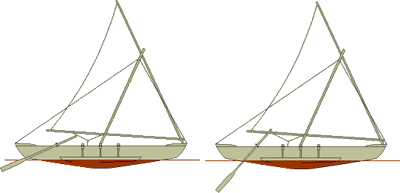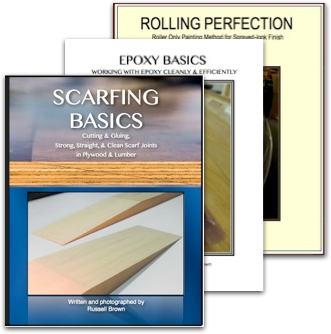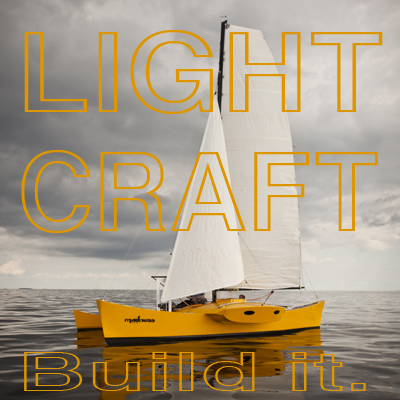The Case for the Steering Oar
By Gary Dierking
Steering is one of the great challenges of proa design. The one who finally designs a steering system that a) shunts easily, b) controls the canoe both while at speed and while stationary during a shunt, c) is hydrodynamically efficient, d) is immune to underwater hazards, and e) is simple and foolproof, will have discovered the proa “holy grail”. Could it be that the Pacific Islanders have already invented such a wondrous device?
My first experience with a steering oar was not auspicious. In Coast Guard boot camp I managed to talk my way into steering one of the big whaleboats used for training and racing. We must have had all the strong guys on one side as my best effort was not enough to prevent ramming one of the other boats; causing an automatic disqualification and my demotion to rowing guy. It took quite a few years before I realized that a steering oar is much more than a rudder. If I had used the oar function I could have avoided the collision.
Based on my experience with my 16’ and 31’ proas I’ve used the steering oar in at least four different modes:
- The oar can function as a rudder by simply immersing the blade and angling it to turn the canoe. This mode is most commonly used for course correction on broad reaches and for rounding up into the wind to drop the sail.
- As a sweep. Going aback is the biggest no-no with shunting proas and can necessitate dropping the sail or even cause a capsize. If you sail long enough it will happen. Sailing up under headlands or getting a sudden windshift can put you into an embarrassing situation. This is where the steering oar has saved my bacon on several occasions. Using it as an oar with a powerful sweeping motion will kick the stern of the canoe around right now. This is something you can’t do with a rudder.
- I also use the oar as a movable source of lateral resistance by simply trailing it with no angle of incidence, but varying the amount of immersion. If I’m beam reaching and want to bear off, I’ll angle the oar deeper into the water and the canoe will turn down wind. This produces less drag than using the oar as a rudder and is readily apparent by the lack of turbulence.
- Lately I’ve been practicing a sculling stroke to propel the canoe in calms. This works amazingly well and I’m sure I’ll get better with practice. A fully rigged sailing canoe is rarely well set up for paddling and the seamless transition from control to propulsion is a real delight. There’s an article in WoodenBoat Magazine number 100, May/June 1991 with all of the techniques illustrated.

Left - Normal angle with which oar is held during reaching and running courses.
Right - To bear away from the wind quickly as when preparing for a shunt, sheet in hard and angle the oar deeper.
The pine oar on board the 31’ Te Wa is 11 ft (3.35 m) long and weighs 9.5 lbs (4.5 kg). The shaft is 2 1/4" (55mm) in diameter; the blade is 4’ (1.2 m) long and 5 1/2" (140 mm) wide. It is pivoted in a "U" shaped yoke on either end of the leeward side of the canoe. During the shunt, the oar is simply dropped into the water and allowed to float with its tether to the new stern where it is picked up by the crew. This length is adequate but when I build another it will be longer. This would enable one to steer standing up, which is useful when maneuvering in close quarters. As a general rule of thumb I would recommend that steering oars be approximately one half the length of the canoe.
The 16’ Tarawa uses two 7’ 6" standard rowing oars mounted in rowlocks about 8" (200 mm) to windward of the side of the hull. Having two oars saves some time in the shunt which is more important on the smaller canoe. Mounting them on the windward side means that everything can be controlled without moving from your position on the windward seat. As the oar is mostly unnecessary on windward courses, there is no problem with the blade running in the vortex turbulence of the hull.
So after all the good stuff, what’s the down side? Scaling the steering oar up to larger canoes can turn into real oceanic he-man stuff. Pacific museums contain huge steering oars that take two men just to lift. This is all very well on an afternoon sail but not what you want on an ocean passage with your girlfriend.
I see steering to be the biggest challenge in making the shunting proa acceptable to a wider range of sailors. Plenty of proa sailors are using some form of dagger/rudders installed in the main hull. The results have been widely variable with some claiming great success and others recommending that I have nothing to do with it. It’s a deceptively complex issue depending on hull shape, daggerboards and type of sailing rig employed. So there is still much work to be done before we go on prime time with a 60’ proa. In the mean time I’m greatly enjoying the secure feeling I have sailing at speed through thin and obstructed water and not worrying about what could happen below.
Gary Dierking has lived most of his adult life on one Pacific island or another, first in Hawaii, and now in New Zealand. He has sailed across much of Polynesia and Micronesia in a Searunner trimaran, where he saw the speedy proas of the islands first hand. Now he is building modern interpretations of Oceanic sailing canoes, and has achieved considerable success with ancient forms realized in modern materials. See his work at Outrigger Sailing Canoes.




That’s super helpful thanks for sharing your insights! I just bought a 34’ Proa and I want to sail it in the Bahamas so naturally I thought of using an oar. But your experience will save me lots of time experimenting.
Cheers,
Christian